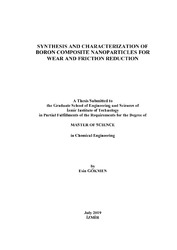Please use this identifier to cite or link to this item:
https://hdl.handle.net/11147/7341Full metadata record
| DC Field | Value | Language |
|---|---|---|
| dc.contributor.advisor | Polat, Mehmet | - |
| dc.contributor.author | Gökmen, Esin | - |
| dc.date.accessioned | 2019-11-06T13:20:07Z | - |
| dc.date.available | 2019-11-06T13:20:07Z | - |
| dc.date.issued | 2019-07 | en_US |
| dc.identifier.citation | Gökmen, E. (2019). Synthesis and characterization of boron composite nanoparticles for wear and friction reduction. Unpublished master's thesis, İzmir Institute of Technology, İzmir, Turkey | en_US |
| dc.identifier.uri | https://hdl.handle.net/11147/7341 | - |
| dc.description | Thesis (Master)--Izmir Institute of Technology, Chemical Engineering, Izmir, 2019 | en_US |
| dc.description | Full text release delayed at author's request until 2020.04.04 | en_US |
| dc.description | Includes bibliographical references (leaves: 70-72) | en_US |
| dc.description | Text in English; Abstract: Turkish and English | en_US |
| dc.description.abstract | Since most of the conventional lubricants reach their performance limits, new antiwear and extreme pressure (EP) additives are designed so that lubricants can minimize friction and wear when used in high temperature and pressure conditions. There is growing interest in the use of nanoparticles as an additive in lubricants. Due to its outstanding chemical properties, boron is frequently involved in the design of nanoparticles. Especially borate derivatives and hexagonal boron nitride (h-BN) have already taken their places in many lubricant formulations. The aim of this study was the production of silica-boron composite nanoparticles that can replace the phosphate-derived additives used in lubricant formulations and to provide the extreme pressure, antiwear and friction-regulating properties at the same time. For this purpose, the Stöber method that is used for silica production was modified to produce Si/Na-Borate nanoparticles. It was found that the synthesis of composite nanoparticles in desired size distribution and morphology as well as composite structures composed of Si and Na-Borate, was possible changing the amounts of ingredients and modes of addition. It was observed that the morphology and the chemical structure of these particles depend on the amount of Na-Borate (1, 3, and 5% w/w) and the addition type of Na-Borate (Direct, 500 �����L/min, 5�����L/min). Then composite nanoparticles were characterized using SEM, FTIR and ICP-MS and some tests were conducted to examine the structure of particles. The tribological performance of these particles tested using Four Ball Test method have shown that there is a significant improvement in the presence of these particles. | en_US |
| dc.format.extent | xii, 72 leaves | en_US |
| dc.language.iso | en | en_US |
| dc.publisher | Izmir Institute of Technology | en_US |
| dc.rights | info:eu-repo/semantics/openAccess | en_US |
| dc.subject | Amorphous silica | en_US |
| dc.subject | Sodium borate | en_US |
| dc.subject | Surface wear | en_US |
| dc.subject | Boron | en_US |
| dc.subject | Composite nanoparticles | en_US |
| dc.title | Synthesis and characterization of boron composite nanoparticles for wear and friction reduction | en_US |
| dc.title.alternative | Aşınma ve sürtünmeyi azaltmak için bor kompozit nanotanelerin sentezi ve karakterizasyonu | en_US |
| dc.type | Master Thesis | en_US |
| dc.institutionauthor | Gökmen, Esin | - |
| dc.department | Thesis (Master)--İzmir Institute of Technology, Chemical Engineering | en_US |
| dc.relation.publicationcategory | Tez | en_US |
| item.languageiso639-1 | en | - |
| item.fulltext | With Fulltext | - |
| item.openairecristype | http://purl.org/coar/resource_type/c_18cf | - |
| item.openairetype | Master Thesis | - |
| item.grantfulltext | open | - |
| item.cerifentitytype | Publications | - |
| Appears in Collections: | Master Degree / Yüksek Lisans Tezleri | |
Files in This Item:
| File | Description | Size | Format | |
|---|---|---|---|---|
| 10142660.pdf | MasterThesis | 8.58 MB | Adobe PDF |  View/Open |
CORE Recommender
Page view(s)
176
checked on Jul 22, 2024
Download(s)
602
checked on Jul 22, 2024
Google ScholarTM
Check
Items in GCRIS Repository are protected by copyright, with all rights reserved, unless otherwise indicated.